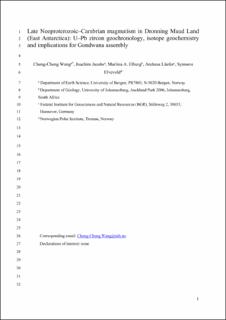| dc.description.abstract | Dronning Maud Land (DML) is a key area for the better understanding of the geotectonic history and amalgamation processes of the southern part of Gondwana. Here, we present comprehensive new zircon U–Pb–Hf–O, whole-rock Sm–Nd isotopic and geochemical data for late Neoproterozoic-Cambrian igneous rocks along a profile from central to eastern DML, which provides new insights into the crustal evolution and tectonics of the region. In central DML, magmatism dominantly occurred at 530–485 Ma, with 650–600 Ma charnockite and anorthosite locally distributed at its eastern periphery. In contrast, eastern DML experienced long-term and continuous granitic magmatism from ca. 650 Ma to 500 Ma. In central DML, the 650–600 Ma samples are characterized by highly elevated δ18O (7.5–9.5‰) associated with slightly negative to positive εHf(t) values (−1 to +3), indicating significant addition of high-δ18O crustal components, such as sedimentary material at the margin of the Kalahari Craton. Evolved Hf isotopic signatures (εHf(t) = −15 to −6) and moderately elevated O isotopic data (δ18O = 6–8‰) of the Cambrian granitic rocks from central DML indicate a significant incorporation of the pre-existing, old continental crust. In eastern DML, the suprachondritic Hf–Nd isotope signatures and moderate δ18O values of the late Neoproterozoic granites (650–550 Ma) from the Sør Rondane Mountains support the view that they mainly originated from crust of the Tonian Oceanic Arc Super Terrane (TOAST). The post-540 Ma granites, however, have more evolved Hf and Nd isotopic compositions, suggesting an increasing involvement of older continental components during Cambrian magmatism. Nd isotopes of the Cambrian granitic rocks in DML display an increasingly more radiogenic composition towards the east with model ages ranging from late Archean to Mesoproterozoic times, which is in line with the isotopic trend of the Precambrian basement in this region. The late Neoproterozoic (>600 Ma) igneous rocks in central and eastern DML were emplaced in two independent subduction systems, at the periphery of the eastern Kalahari Craton and somewhere within the Mozambique Ocean respectively. The accretion and assembly of the TOAST to the eastern margin of the Kalahari Craton and their collision with surrounding continental blocks was followed by extensive post-collisional magmatism due to delamination tectonics and orogenic collapse in the Cambrian. The late Neoproterozoic–Cambrian igneous rocks in DML thus record an orogenic cycle from subduction-accretion, continental collision to post-collisional process during and after the assembly of Gondwana. | en_US |

